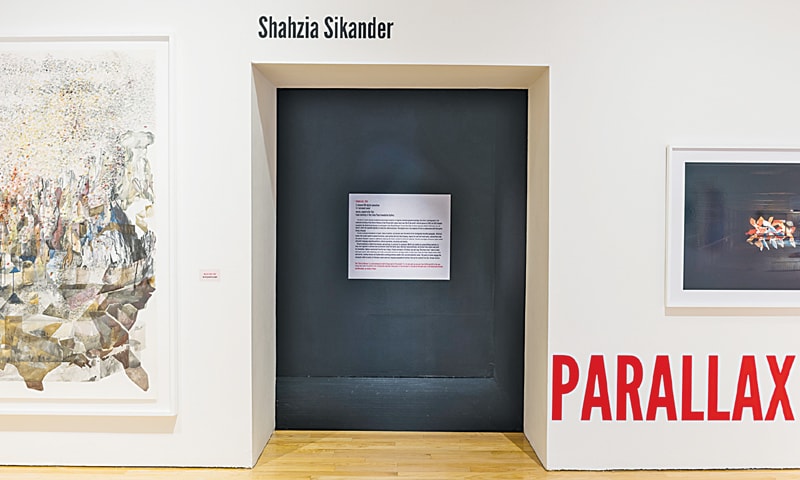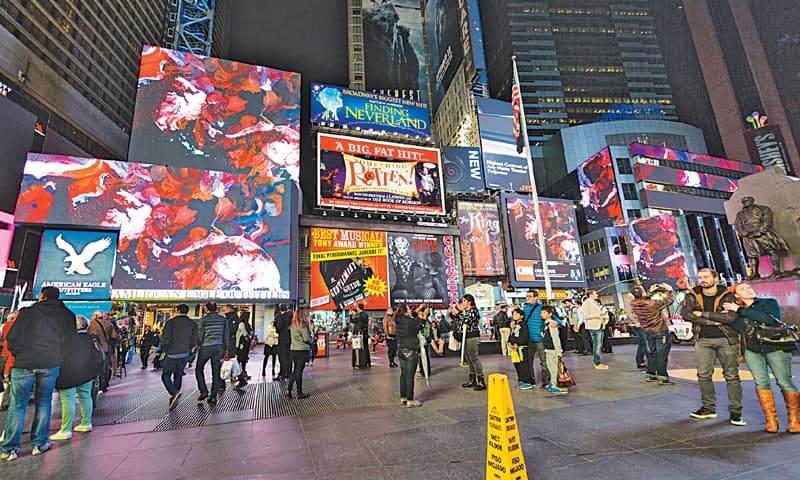Pakistan’s best export to the United States is none other than the celebrated artist Shahzia Sikander. More than two decades of her multitudinous art practice has culminated in a series of recent public events that both employ her work as a highpoint of contemporary artistic expression as well as pay a tribute to her unreserved originality. This October was Sikander’s moment. From the electronic billboards at Times Square in New York City to Frist Center for the Visual Arts, Nashville, Sikander features as an icon herself.
At Frist, Nashville, an exhibit of Islamic art entitled “Ink, Silk and Gold” showcases a painting by Sikander called ‘Pathology of suspension # 6’. This work, as before, is a testament of her dexterity of expanding the classical miniature form and taking it to a new meaning. Taller than six feet, the painting juxtaposes the traditional illumination of an Islamic manuscript with the contemporary Western art forms. Its expanse enlarges the ideas of traditional artworks on display; and also initiates a conversation between the civilisations. “I am overjoyed at the idea of my work being treated as a continuation of a great tradition,” said Sikander.

Concurrently in her adopted city, the Big Apple, her work has been presented to thousands of spectators breaking free of gallery spaces. The intersection of traditional miniature strokes, technology and themes concerning modernity have resulted in ‘Gopi-Contagion’ — an animation that expands, fritters and creates multiple realities not unlike the city itself.
I spoke to Sikander as she was rushing to catch a plane for another event. Her excitement about the public display in Times Square was palpable, “I have received incredible feedback from general viewers and tourists.” This was being recognised in “your own backyard” and conversing with your work in the public arena. Each night at Times Square, just before midnight, Sikander’s animations playing on the symbol of Gopi’s hair (a devotee of Hindu god Krishna), transport the viewers into the multiple possibilities of Gopi’s imagination.

Shahzia Sikander takes miniature art form to a different dimension, both in terms of scale as well as the use of media
When in motion, the silhouettes of Gopi’s hair resemble insects, birds, bats, or can translate as a particle. Billboards between the 42nd and 47th Streets (Broadway and 7th Avenue) Manhattan light up with the essentialist miniature drawings, numbering in thousands and reaffirm the power of the format.
It was Sikander who led the miniature revival movement as a young student of National College of Arts, Lahore, in the early 1990s. Later she moved to the United States where she has taken the miniature art form to a different dimension both in terms of scale as well as the use of media. What was essentially an exclusive, courtly practice has been reinvented by her and increasingly with the use of new technologies.

On Oct 15, Sikander spoke at the Galleries and Collections at Tufts University where her works are also being shown. In her own ‘backyard’, Sikander was in conversation with Brooklyn Museum’s director Anne Pasternak at the New York Public Library recently. Her video animation Gold Oasis 2015 is being showcased at an exhibit entitled “perfrom(art)ive” at Twelve Gates Gallery in Philadelphia. Gold Oasis video using elegantly carved architectural motifs comments on the recent Ebola outbreak and uses music to illuminate. At the famed Metropolitan Museum of Art, NYC Sikander’s scintillating commentary accompanies the displayed Persian painting ‘Laila and Majnun’ from Nizami’s Quintet.

In our earlier conversations, Sikander had complained about the art establishment in Pakistan. Some viewed her as an ‘outsider’ at ‘home’. This time she sounded upbeat. The world and Sikander have embraced each other thereby redefining her identity. Not too different from boundless prospects inherent to a Gopi’s imagination.
Raza Rumi is an author and a journalist. Currently he is a scholar-in-residence at Ithaca College, USA.
Published in Dawn, Sunday Magazine, November 8th, 2015
On a mobile phone? Get the Dawn Mobile App: Apple Store | Google Play
















































Dear visitor, the comments section is undergoing an overhaul and will return soon.